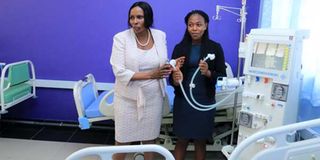Equipment scheme seeks to build renal units in the counties

Mary Matu (left) Angelica medical supplies executive director with Joan Jepleting, a bio medical engineer during interview in one of a dialysis machine at Mbagathi hospital on February 23, 2017. PHOTO | JEFF ANGOTE
What you need to know:
- In 2015, Ms Matu won a government tender to supply, install, test, maintain and replace over 200 dialysis machines in the country. The seven-year project — 2015 to 2022 — involved building and equipping 49 renal units in the country.
- The biggest impact of the project, to her, has been the shortening of the long distances patients had to travel to access renal care
- Ms Matu’s project, in a way, seeks to right the wrongs of the past. In the two years it has been in operation, it has carried out over 24,000 dialysis sessions and has 2,000 regular patients. This month she hopes to commission the 48th renal unit, at Mbagathi District Hospital in Nairobi.
From her first-floor office in Hurlingham, Nairobi, Ms Mary Matu follows one of Kenya’s most intriguing health stories in real-time from a screen mounted on the wall opposite her desk.
As the executive director of Angelica Medical Supplies, she has the daunting task of ensuring that a Sh2.3 billion kidney dialysis project funded by the government under the Managed Equipment Services initiative is up and running.
And, to do that, she needs by-the-hour reports from all over the country on what is happening in the 47 renal units whose operations she manages across the country.
It is an intimidating task, but she cannot have it any other way.
“My joy comes from knowing that we are changing lives,” she says. “I have worked in both the private and public health sectors, and I have discovered that the simple pleasures in this field come from addressing the immediate health needs of patients.”
But, even in that steely optimism, Ms Matu agrees that she sits atop one of the country’s most ambitious health projects. Chronic kidney disease is a growing cause of death and disability in the country. It is estimated that two to four million Kenyans suffer from the disease, and a large number of these progress to end-stage failure unnoticed. Currently, about 10,000 patients require dialysis as a form of renal replacement therapy, but only 10 per cent can access the service.
BIG IMPACT
In 2015, Ms Matu won a government tender to supply, install, test, maintain and replace over 200 dialysis machines in the country. The seven-year project — 2015 to 2022 — involved building and equipping 49 renal units in the country. So far, 47 seven such units have been set up, from Mandera to Nairobi to Mombasa to Kisumu. Only two counties — Turkana and Tana River — do not have the centres so far, but construction works are on course.
The plan is to equip each unit with five dialysis machines, two dialysis beds, one reverse osmosis plant, and various furniture.
The biggest impact of the project, to her, has been the shortening of the long distances patients had to travel to access renal care. “On average, kidney patients need at least two dialysis sessions every week, for life,” she explains. “Before we started this project there were only four regional centres in the country where one could get the services — at Kenyatta National Hospital in Nairobi, Nakuru Provincial General Hospital in Nakuru, Jaramogi Oginga Odinga Teaching and Referral Hospital in Kisumu, and Coast General Hospital in Mombasa.
“Can you imagine the trouble a dialysis patient in Mandera, or even Machakos, would have to go through to just access a dialysis machine?”
The story of Kenya’s kidney disease management is one fraught with missteps and utter criminal neglect. For one, between independence and 1978, the country had only one dialysis machine, at KNH.
And then, between 2002 and 2013, the four regional centres were set up in Nairobi, Kisumu, Nakuru and Mombasa. But these could not serve the tens of thousands of Kenyans who needed dialysis, and so long queues and desperate, long faces were common in the waiting bays.
Ms Matu’s project, in a way, seeks to right the wrongs of the past. In the two years it has been in operation, it has carried out over 24,000 dialysis sessions and has 2,000 regular patients. This month she hopes to commission the 48th renal unit, at Mbagathi District Hospital in Nairobi.
“The cost of a single dialysis session is between Sh8,000 and Sh16,000,” she says. “That means often-desperate and poor patients would be forced to spend between Sh20,000 and Sh40,000 every week for the two dialysis sessions, when you factor in the associated transport and accommodation costs. But, through a partnership with the National Health Insurance Fund, Kenyans do not pay a single cent to access the services.”
When she set out, there were concerns that she would face political headwind as health is a devolved function, and critics argued that the central government had no business “meddling” in that area.
But through persistence, lobbying and several meetings with county leaders, the project gained traction. Now she is training the bio-medical engineers and nurses who will run the project after seven years, when she exits the stage and hands over the management of the renal units to the county governments.


